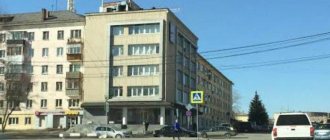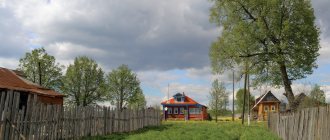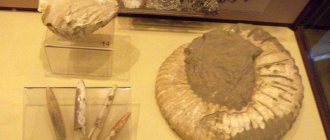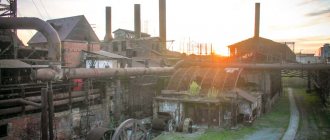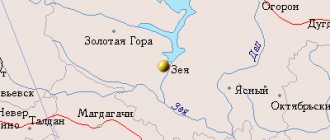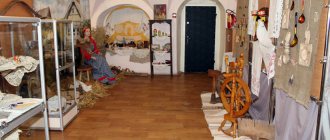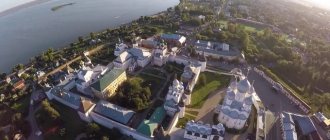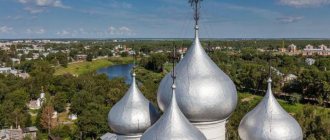Our country is an amazing place. You can study it for an endless number of years and each time you discover something new and be surprised by interesting facts. Of course, throughout Russia’s long existence, many good books have been written on its history. However, we all know that it is better to see once than to hear a hundred times - it is better to immerse yourself in the atmosphere of history once, to make a fascinating journey to its origins, than to read about some, even the most fascinating, facts and events. This is probably why many of us love to visit a variety of museums, each of which has its own characteristics and unique features.
One of these is the historical and local history department of Nizhny Tagil. You can read about it in this article.
History of the museum
The Nizhny Tagil Museum of Local Lore is part of a whole complex of cultural and historical objects united in the Nizhny Tagil Museum-Reserve "Gornozavodskoy Ural". Moreover, the local history museum heads this complex, and at the same time is the oldest museum in the city. It was founded in 1840, the museum was then called the “Museum of Natural History and Antiquities.” Exhibits from the collection were previously exhibited at an exhibition created for Tsarevich Alexander Nikolaevich.
Later, in 1891, the Museum’s collection was supplemented with exhibits from the Vyya Museum. It was then that the new “Mining Museum of the Nizhny Tagil and Lunievsky Plants” was open to the public, because before that the purpose of the museum was only to collect and store antiquities, and only students of the Demidov Vyisky Technical School could view the exhibition.
However, the museum did not work for long - due to lack of funding, in 1907 it was forced to stop working. It was resumed only in 1924, the collection was supplemented with new exhibits, and the museum was renamed the Nizhny Tagil Museum of Local Lore. The cultural object acquired the name of the Nizhny Tagil Historical and Local History Museum in the late eighties of the twentieth century, when the department dedicated to nature was removed from it.
THE COOLEST MUSEUMS OF NIZHNY TAGIL
Nizhny Tagil
is not the most tourist place, not only in the Sverdlovsk region, but also in Russia. It is very famous for its huge factories, such as the Nizhny Tagil Iron and Steel Works (NTMK) and Uralvagonzavod (UVZ), which are its city-forming enterprises. Also among such enterprises one can put “UralKhimPlast” and “Sverdlovsk Railway”, which successfully exports the products of these enterprises. Yes, I still work there...
A LITTLE EXCURSION INTO THE HISTORY AND GEOGRAPHY OF MY CITY
My favorite city is located in the Sverdlovsk region, near the conventional border between Asia and Europe, conveniently located on the eastern slope of the ancient Ural Mountains. The area of the city is slightly less than 300 square meters. kilometers, which also allows it to take 2nd place in terms of occupied area among the cities of the Sverdlovsk region. Local population slightly exceeds 350,000
“Magnit Gora” (High) was first mentioned in the 2nd half of the 17th century, but the mining of iron and copper ore began in 1721, when A. N. Demidov built 2 plants: Vyisky copper smelter (10/23/1722 ) and Nizhny Tagil iron-making, iron-smelting (12/25/1725). The Nizhny Tagil plant in the 18th century became one of the most significant factories in Europe and Tagil iron with the “Old Sable” brand began to be bought by the British, Dutch, French and Swedes
As mentioned above, the history of the formation of the city began back in 1722, and since 1806 it has been recognized as the center of the Nizhny Tagil Mining District. At the beginning of the 19th century, deposits of copper ore, gold, platinum, malachite and other precious stones were discovered near the settlement, and thus the development of the stone processing industry began. A railway passed through the settlement in 1876, and then in 1897 a narrow-gauge railway was built, which connected the Nizhny Tagil, Chernoistochinsky, Visimo-Shaitansky and Visimo-Utkinsky factories.
The first of the factories was visited by many famous historical people, among whom was the Tsarevich - Emperor Alexander II (1837)
Nizhny Tagil is associated with many talented people. At the Vyysky plant, talented serf inventors Efim Alekseevich and Miron Efimovich Cherepanov (my distant relatives) in 1834 invented and built the first Russian steam locomotive to transport ore from the deposit to the plant. E. G. Kuznetsov-Zhepinsky was also a great talent, who made original astronomical clocks and “musical droshky”, original in their kind. Moreover, according to one of the legends, Nizhny Tagil artisan Artamonov Efim designed the first bicycle in Russia at the beginning of the 19th century
My city can also be considered the patrimony of the Russian painted iron tray, the famous artists Khudoyarovs.
In 1919, the industrial village received the status of a city
. Most of the attractions of Nizhny Tagil are various museums that can tell a lot about the history of the region, our famous aborigines, as well as its industry
I strongly recommend that guests and tourists who are interested in the history of the Urals, its activities and culture visit all the museums of the city
And I suggest you start your journey according to the route map provided.
Demidovskaya dacha
Address: st. Krasnogvardeyskaya, 5A. Opening hours: from 9-30 to 17-30, days off: Monday and Tuesday. Ticket price: 100 rubles for everyone, 75 rubles for pensioners and students, 50 rubles for students
The house was built in the mid-19th century by order of engineer Fotiy Shvetsov. A native of serfs, he had such incredible engineering talent that the Demidovs sent him to study abroad, giving him his freedom. After graduating, Shvetsov, thanks to his extraordinary approach to business, managed to double the production of factories. The building belonged to a brilliant engineer until 1855, and then became the property of the Demidovs, who happily abandoned it
At the beginning of the twentieth century, the house was restored, completely rebuilding the second floor, where a museum exhibition was placed. Now here you can learn about the life and work of the great engineer, see his desk with working papers and documents
Second floor
- this is the interior of the front hall of the estate, in which the original furnishings of the 19th century are exhibited and portraits of the Demidovs hang. Also on the second floor there is the “Demidov Hall”, where exhibitions and other events are regularly held. In one of the wings there is a kitchen with all the necessary utensils
Nizhny Tagil Museum of Fine Arts
Address: st. Uralskaya, 4, 5, 7. Opening hours: Tuesday - Sunday from 9-30 to 18-00, Thursday from 11-30 to 20-00, closed on Monday. Ticket price: 150 rubles for everyone, 100 rubles for pensioners and students, 50 rubles for students, 20 rubles for preschoolers
The Museum of Painting is included in the list of the largest museums in the city and the second largest museum of fine arts in the region
The Museum of Fine Arts is housed in three old, historic buildings in the city center. The main building is a three-story building from 1865, built in the Russian City Merchant style. Tagil merchant P. T. Aksenov. This is where the largest number of exhibition halls is located and where the museum administration is located. Near the building behind the fence there is a small garden with park sculptures. There is a glass dome with prism-shaped windows on the roof for additional lighting.
In the post-war years, the building was rebuilt and the area was increased 1.5 times due to a two-story extension. On the roof of the attached building there is also a glass dome with prism-shaped windows, but slightly smaller in size.
At the entrance to the main building there is a sculpture of the “City Angel” by local sculptor Alexander Ivanov, consisting of 2 figures - the angel himself (a 45-year-old man, dressed in a coat and a hat with wings on his back), and a small dog sits at his feet
Opposite the main building is the second two-story building of the Museum and red brick. It houses creative studios of local sculptors and artists. This building is also made in the Russian style, but still more reminiscent of the Russian Museum in Moscow, and not the Merchant City style. The roof is topped with two decorative turrets, and the building is recognized as a monument of culture and history of the Ural region
Next to the art studios there is a small two-story building of the Union of Artists of Nizhny Tagil.
Lower provision warehouse
Address: st. Uralskaya, 2
The warehouse was built in the 1760s and 70s. Since 1980, the depository of the Gornozavodskoy Ural Museum-Reserve has been located here. The building of the “Nizhny Provision Warehouse” is one of the oldest buildings in Nizhny Tagil and is an architectural monument of regional significance
In the storage building of the museum-reserve, two exhibitions are open: the interior of the Nizhny Tagil tavern of the 19th-20th centuries and gifts from private individuals. The museum hosts themed quests for schoolchildren with tea drinking from an ancient samovar
Some of the most valuable exhibits of this museum are a malachite tabernacle and a silver vase donated to the Cherepanov family by Prince Demidov, as well as a plate with a coat of arms from the Demidov service and a small collection of Ural minerals. A very large number of tropical butterflies and antique furnishings from the Demidov house in pre-revolutionary Tagil are presented.
Museum of Nature and Environment (upper food warehouse)
Address: Lenina Ave., 1A. Opening hours: Wednesday and Saturday from 9-30 to 17-30, Thursday from 11-00 to 19-00, Friday from 9-30 to 16-30. Closed days: Monday and Tuesday. Ticket price: 40 rubles - adults and 20 rubles - children
The museum, created to promote environmental protection, opened 15 years ago. The museum's exhibits are housed in a classic early 19th-century food storage building. For some time, the building was used as a garage for the city government.
The museum's exposition tells about deposits of iron and copper ore, the development of platinum and gold placers, and semi-precious mines. There is a model of the Mednorudyanka mine, concentrates of gold and platinum, as well as a half-ton block of malachite
A separate exhibition presents wildlife and environmental problems of the city. Moreover, the museum presents a unique paleontological collection of skeletons of the mammoth family
At the end of the building there is a monument to the legendary tank of the Great Patriotic War: T-34
Historical Museum of Local Lore
Address: Lenin Ave., 1. Opening hours: Wednesday, Friday, Saturday from 9-30 to 17-30, Thursday from 11-00 to 19-00, Sunday from 9-30 to 16-30. Closed days: Monday and Tuesday. Ticket price: 60 rubles - full ticket, 30 rubles - discounted ticket and 20 rubles - children's ticket
The local history museum is located in the building of the former administration, the Demidov mining plant. The building was erected in 1830 by the Ural master architect A.Z. Komarov
The modern Museum of History and Local Lore appeared in 1840 as the “Museum of Natural History and Antiquities” and was created on the basis of exhibits from an exhibition for Tsarevich Alexander Nikolaevich, who came to Nizhny Tagil in 1837. It was a closed institution engaged in the collection, storage and study of collections, their use as teaching aids for students of the Demidov Vyisky Technical School
In 1891, the collection of the “Museum” was combined with the collection of the Vyisky Museum, where they created the “Mining Museum of the Lunievsky and Nizhny Tagil Plants”, open to visitors. However, it worked until 1907 and was successfully closed due to lack of funding, which led to the loss of some exhibits
The museum opened only in 1924. Like the local history museum of Nizhny Tagil. Its exhibitions were replenished with rare objects from the surrounding churches and “Lord’s Houses”. The museum acquired its modern appearance by the end of the 80s of the 20th century, when the department of nature was removed from its composition.
Nizhny Tagil Museum-Reserve
Address: Lenin Ave., 1. Opening hours: Wednesday, Friday, Saturday from 9-30 to 17-30, Thursday from 11-00 to 19-00, Sunday from 9-30 to 16-30. Closed days: Monday and Tuesday. Ticket price: 60 rubles - full ticket, 30 rubles - discounted ticket and 20 rubles - children's ticket
The history of the development of our mining district is very widely represented in the state museum-reserve "Gornozavodskoy Ural", which unites 16 museums and various objects conveniently located throughout the district
The museum-reserve was founded in 1841 by P. N. Demidov and was called the “Museum of Natural History and Antiquities” as a cabinet of curiosities in honor of the arrival of Tsarevich Alexander to local factories. The museum included: a library, an archive, a number of collections (geological, mineralogical and metallurgical) and objects of the industrialists Demidovs
Plant-museum of mining equipment
Address: Lenin Ave. Excursions by appointment (phone, 41-64-01). Ticket price: 600 rubles for a group of 10 people. Age from 14 years
The museum was opened at the locomotive production plant founded by A. Demidov back in 1725. The plant stopped working in January 1989, and its premises became a museum of mining equipment
This is the only and first museum-factory in our country with a full cycle of metallurgical production, including 6 exhibitions: open-hearth and blast furnace shops, rolling production, energy management, instruments for metal machining, furnace production and foundry. There are three expositions - rolling stock, mining and factory equipment. The locks, canals, spillways of the 18th century and workshops of the 19th century have been preserved in their original form, and the blast furnaces are already from the 1920s and 30s
The blast furnace shop is presented in its original form, where you can see mechanisms designed by the great Ural masters Cherepanov, Polzunov and Shvetsov
The factory tour is only open in the summer. The plant museum is an object of federal significance for the history and culture of the Ural region
Fox Mountain
Address: st. Lisogorskaya, building 1. Museum opening hours: from 14-00 to 16-00. Ticket price from 15 to 40 rubles
Fox Mountain rises 265 meters and is one of the main symbols of the city. It is located almost on the shore of the Tagil pond. A monument to metallurgists was erected at the foot of the mountain. On the top of the mountain, Demidov built a stone watchtower in 1818
There is still controversy regarding her appointment.
The appearance of the first tower on the mountain is not known for certain. The tower was wooden and was built as an observation deck, on which a guard-observer monitored the surrounding area and immediately raised the alarm when he saw a fire.
In 2015, the tower was renovated and housed the smallest museum in the world, the Tower on Fox Mountain. The museum is open in summer and in winter by appointment only. In the museum premises there is a signal bell, which once warned of fires, as well as household items and clothing of the tower guards.
Not only tourists and city guests, but also local aborigines often climb to its top, as the unforgettable landscape of Nizhny Tagil opens up from above. There are well-trodden paths leading to the top of the mountain, however, the most convenient is a stone path consisting of several levels. Each level has a bench where you can rest. Climbing to the top of Fox Mountain you can admire the city from a bird's eye view and see the Watchtower
Local residents of the city believe that Fox Mountain is nothing more than an extinct ancient volcano.
House of self-taught craftsmen Cherepanovs
Address: st. Verkhnyaya Cherepanova, 1. Opening hours: Wednesday, Friday, Saturday from 9-30 to 17-00, Thursday from 11-00 to 18-30, Sunday from 9-30 to 16-00, non-working days: Monday and Tuesday . Ticket price: 60 rubles for everyone, 40 rubles for students and pensioners, 30 rubles for schoolchildren
The Ural "Kulibins" father and son Cherepanovs developed the first Russian steam locomotive in 1833. The stone house with the estate in which they lived was given over to the museum only in 1984, and before its opening, the management of the Vyya copper smelter lived here and government agencies were located. And it began functioning as a museum 20 years later.
The Cherepanovs' house was built in the classicist style in the 19th century (1830) according to the design of the architect Alexander Chebotarev
The museum exhibits tell the story of the development of metallurgy in our city. Here are the drawings of the inventors Cherepanovs and their followers. A model of the railway along which the locomotive moves has been recreated. Personal belongings and furniture of the Cherepanov family are shown
In the courtyard of the museum there are models of the first steam locomotive and engineer Artamonov’s bicycle. The museum definitely deserves special attention
Lord's house
Address: st. Tagilskaya, 26. Opening hours: Wednesday – Saturday from 9-30 to 17-30, Sunday from 9-30 to 16-30, non-working days: Monday and Tuesday. Ticket price: 60 rubles for everyone, 40 rubles for students and pensioners, 30 rubles for children
The house, built in the first half of the 19th century with features of late classicism, was the estate of the merchant Deryabin, who at one time sold the building to the Administration of Factories of the Nizhny Tagil District. When Soviet power came, the building was converted into communal apartments. And only in the 20s of the twentieth century the building was given over to the museum’s exhibition hall. From 1997 to the present, the Museum of Life and Crafts of the Mining Population of the Urals has been operating here.
The estate house has a stable yard, a carriage house and a garden stretching to the Tagil River
From the museum's exhibits, one can easily imagine the life of the factory foremen and their managers. The interiors of houses, household items and clothing have been recreated here. Craft items are on display: homemade chests, birch bark products and embroidery
Museum of the History of Tray Crafts “House of the Khudoyarovs”
Address: st. Tagilskaya, 24. Opening hours: Wednesday-Saturday from 9-30 to 17-00, Sunday from 8-30 to 16-00, non-working days: Monday and Tuesday. Ticket price: from 20 to 50 rubles
The house was built in the mid-19th century and before the advent of Soviet power belonged to the Khudoyarov dynasty of artists. And only in 1991, the Museum of Tray Craft was opened in a wooden building.
The museum exhibits tell about the emergence of Ural lacquer painting, about the life and work of the Khudoyarov artists (personal belongings of the masters, tools, special devices and various documents). The museum houses exclusive works by masters of lacquer painting on metal with a history of almost three hundred years.
Local craftsmen and artists, the Khudoyarovs, made trays from pieces of metal and painted them with flower buds so skillfully that their creations were not only liked by local nobles, but were also successfully sold abroad
Excursions
The Nizhny Tagil Museum of Local Lore offers a large number of different excursions. Each visitor can choose the topic that interests him. The list of excursions includes more than fifteen items. Here are just a few of them: first of all, the museum staff recommend visiting the sightseeing tour “History of our region from ancient times to 1917”, during which you will learn about how the Ural region of Russia developed, and also get acquainted with the history of the local history museum itself Nizhny Tagil. Thematic excursions are dedicated to the culture of the primitive population of the region, the way of life of the indigenous peoples of Mansi, and the history of the development of the Urals by Russians. There are programs telling about books, musical instruments, and the inventions of the Cherepanov brothers.
The main thing is participation
Don’t like to just watch and listen to the guide, but prefer active participation in the program? Then you will definitely appreciate the events that are held in the museum: “The History of Tagil Cinema” dedicated to cinema, “Lesson in the Old School” recreating the atmosphere of a nineteenth-century school, the musical “Melodies of the War Years” and many others. Positive reviews about the Nizhny Tagil Museum of History and Local Lore are often associated with master classes that are regularly conducted by specialists at the museum. You can paint holiday eggs at the Easter Joy MK or find out what Susne-Khum is by attending the corresponding master class.
Architecture
The entire ensemble of the Nizhny Tagil Museum-Reserve “Gornozavodskoy Ural” was supposedly rebuilt in 1833 by the architect A.P. Chebotarev, using the style of late classicism, gravitating towards the works of K. Rossi. Particularly impressive is the central part of the factory administration, decorated with stucco on the pediment and an eight-column Doric portico. Initially, the coat of arms of the Demidovs was placed in the center of the pediment, but during the Soviet Union it was replaced by the coat of arms of the USSR.
Currently, the pediment is decorated with stucco molding in the form of stylized acanthus leaves. The decoration of the second floor windows is the same as that of the outbuilding windows, which is now a local history museum. This architectural move made it possible to make the two buildings a single whole. Also interesting is the interior of the second floor of the building, the floor of which is covered with figured cast-iron slabs; you can get to it via a cast-iron staircase with openwork cast-iron railings, the result of the work of Tagil craftsmen of the first half of the 19th century.
© Mitrokhina Marina
Location
The museum is located at the address: Nizhny Tagil, Lenin Avenue, building number 1. Finding the Nizhny Tagil Museum of History and Local Lore is not difficult - it is located in the very center of the city. The museum building also deserves attention - previously there was a laboratory of the Factory Office; Together with the City Council building, the outbuilding forms a single architectural complex “Tagil Kremlin”.
The building was built in the mid-nineteenth century according to the design of Alexander Petrovich Chebotarev and is currently an architectural monument of federal significance. It was transferred to the disposal of the local history museum in 1997.
Museum expositions
Each museum object of the Nizhny Tagil Museum-Reserve "Gornozavodskoy Ural" is unique. Exhibits from all departments of the museum introduce the history of the formation and development of mining in the Middle Urals. Over the years, a rich collection of applied art has been collected; it includes artistic casting, metal painting, stone carving and much more.
The only museum-factory in the country acts as a center of the industrial heritage of the Demidovs and connects the civilizations of Europe and Asia in the production structure along the route of the Demidov iron caravans. Now, on its basis, the project “Eco-industrial technology park “Old Demidov Plant” has been developed; it includes adaptation, renovation and use of the space of the Museum-Factory. In the Blast Furnace, Rolling and Open Hearth Shops, visitors can get acquainted with the peculiarities of the functioning of an enterprise powered by electricity, water and steam. The architectural complex of the museum includes a laboratory wing, a dam, old workings, food warehouses, a factory management building and a factory. Thanks to the setting of the buildings, which have preserved the basis of the historical landscape of the 18th-19th centuries, you can easily be transported to the 30-40s of the 19th century. The object of the Industrial Landscape Demidov Park is the Eco-Industrial Technopark, it is designed to preserve the unique mining landscape of the mighty “iron” civilization of the Demidovs of the 18th–20th centuries.
Museum-factory of the history of the development of ferrous metallurgy technology, © Archive of the official website
Once at the exhibition of the Museum of History and Local Lore, which occupies the building of the “laboratory wing” of the Main District Plant Administration, guests will be able to fully understand the history of the Tagil region from ancient times until 1917. The exhibition invites you to plunge into a unique collection of rarities of the Demidov family, get acquainted with archaeological finds from the well-known Gorbunovsky peat bog and advertising items from Nizhny Tagil factories of the 19th century, and appreciate the works of Tagil serf artists.
The Museum of Nature and Environmental Protection generously shares the wealth and originality of the Ural land. The geological collection of the museum includes many rocks, minerals, ores, precious and semi-precious stones from various deposits of Nizhny Tagil and the region, and here you can also find other deposits of Siberia, the Kola Peninsula, Primorye, the Urals and neighboring countries. The highlight of this place is the paleontological hall, where guests can see the skeletons of a female, male and baby mammoth.
The Cherepanov House Historical and Technical Museum occupies a stone mansion, built in 1830–1840 and is an architectural monument of federal significance. The museum exhibition brings guests closer to the traditions of Tagil inventors and introduces them to their life path and inventions, and widely covers the history of the Ural Mining Railway. The astronomical clock of E. G. Kuznetsov, which was created in 1775, and unique author’s drawings of the Cherepanov mechanics are also exhibited here.
The Museum of the History of Tray Crafts, the Ethnographic Complex and the Museum of Life and Crafts of the Mining Population act as custodians of the famous art of Ural lacquer painting on metal and traditional crafts of the mining population. The Museum of Life and Crafts introduces traditional household activities and crafts; it accurately copies the interiors of the houses of wealthy artisans and workers, as well as the living room of a factory manager in the first quarter of the 19th century.
Museum of Life and Crafts of the Mining Population, © Official website archive
The museum-reserve also includes two literary museums: the Literary and Memorial Museum of D. N. Mamin-Sibiryak, by looking at the exhibition of which you can learn almost everything from the history of the village of Visim and become part of the unique history, which is vividly reflected in the books of D. N. Mamin -Sibiryak, and the Memorial Literary Museum of A.P. Bondin, which tells about one of the first writers of the Soviet period in the Urals and introduces the literary life of Tagil.
Memorial Literary Museum of A.P. Bondin, © Archive of the official website
The youngest branch of the museum-reserve is the Demidovskaya Dacha Museum-Estate, which opened in September 2013 in the restored country estate of the innovative engineer F. I. Shvetsov. For Nizhny Tagil, the building serves as the best example of a private country estate of the first half of the 19th century. The museum's exposition introduces the front living room and the mining engineer's office, while the outbuilding became the venue for the permanent exhibition “Russian Cuisine of the 19th Century.”
Once in the tower on Lisya Gora, built according to the design of an unknown architect in 1818, and then restored in 2015, local residents and guests of the city will be able to see the exhibition “Tower on Lisya Gora”, presenting a historical panorama of the city, which was created based on photographs from 1870 -1880s from the collection of the Nizhny Tagil Museum-Reserve.
Literary and Memorial Museum of D. N. Mamin-Sibiryak, © Archive of the official website
Schedule
The Nizhny Tagil Museum of Local Lore is open all week except Monday and Tuesday - these days are days off. On Wednesday the museum opens at half past ten in the morning; on these days of the week it is open until five thirty in the evening. On Thursdays you can visit the museum from eleven in the morning to seven in the evening. On Friday and Saturday, the schedule coincides with the work schedule on Wednesday, but on Sunday the museum stops working an hour earlier than on these days - it closes at four hours and thirty minutes. Moreover, it is worth paying attention to the fact that a ticket can be purchased no later than half an hour before the museum closes - the ticket office stops working thirty minutes earlier.
Cost of visit
To visit the local history museum and the exhibition halls of the museum, you need to purchase an entrance ticket, the cost of which for adults is 70 rubles, for pensioners and students the price will be 50 rubles, and schoolchildren will need to pay only 40 rubles. Moreover, every third Saturday all students and children under eighteen years of age have the right to enter the museum for free, and every last Thursday of the month free admission is provided to large families. Free viewing of the exhibitions of the Nizhny Tagil Museum of History and Local Lore on any day is also provided for heroes of the Soviet Union and heroes of the Russian Federation.
You will have to pay extra for excursion services. A ticket, which also includes a story from a museum employee, costs 400 rubles; for students the same service will cost 200 rubles. The price of a school ticket is 150 rubles, and a preschool ticket is 130.
To take advantage of your right to the discount provided, do not forget the documents that can confirm your social status: school certificate, student ID, pension certificate.
